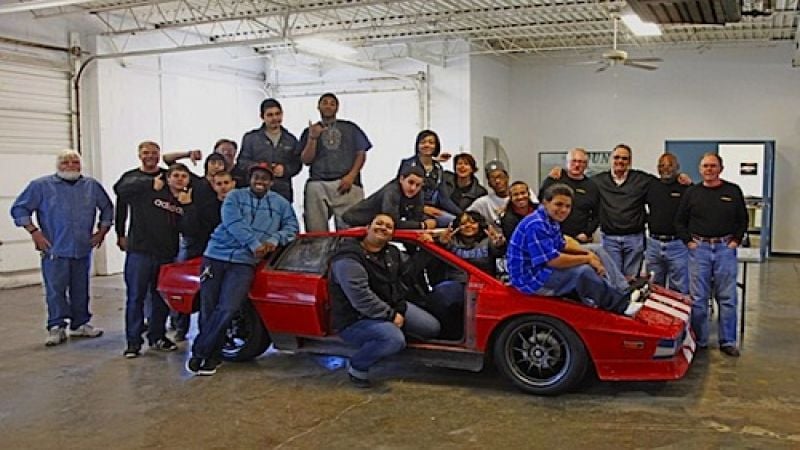When is it OK to convert a classic? This is a question that comes up often in my circle of classic car aficionados. A Lotus Esprit is both an attractive car and a frustrating one, depending on which series you own. The early version kept the Gandini style resolutely intact and even supercar’ish but the Renault mechanic underpinning, no matter how much it was reworked simply didn’t match the expectations the design offered. Later versions had beefier drivetrains but the style was lost in vulgar US forced bumpers and other atrophied aerodynamics. None the less, a Lotus still remains an interesting and attractive electric conversion prospect.
Curious Classic Conversions. Over the few years we’ve seen very interesting electric conversion projects. Some smart, some shocking and others just out right puzzling, they all should make us wonder about the reasons behind. Case in point, converting an old GEO Metro to electricity. It’s smart, fairly simple and you can do it on the cheap. Other older cars and collectables present a different challenge. While there are plenty of under-appreciated 70s and 80s cars, they make a valuable case for a conversion. I’m still toying around converting my 1974 Alfa Romeo Spider to electricity but the continuous drop in Lithium-ion price makes me revisit my options every few months.
Then, there are the classic conversions that presents a serious dilemma. For instance, a year ago I wrote on another news outlet how a few high school students in Kansas City took a 1977 Lotus Esprit with the intention of converting it to electricity. The MINDDRIVE, the brainchild of retired Kansas City architect Richard Stephen Rees, effectively converted it and a year later it was driven coast-to-coast, proving once again EVs can cross from sea to shining sea.
Technically Speaking. The original internal combustion engine was removed and replaced with 30, 3.2-volt Li-ion batteries using a chain-drive motor. Performance wise, the team calculated the electric Esprit averaged 218 MPGe at 40 mph and 138.6 MPGe at 60 mph.
The More Puzzling Conversions. I’m currently eyeing a few mind-boggling conversions that involve classic cars of a higher caliber. One of the biggest is a 1955 Mercedes-Benz 300SL. The owner is a famous architect in the greater Los Angeles area and unashamedly said the cars was his since new and he can do whatever he wants with it. While I can certainly appreciate this, it would be a little harder for me to make that decision. In this case, the 300SL is a much heavier car than a Lotus or Geo Metro and requires much modifications. Effectively, the car will lose its collector title, along with its current value but it will gain a lot more with its electric drivetrain.
The reasons for modifying a collector classic to the point of no return is both personal and involves many intangible angles. In one aspect, converting an old car is a great way to extend its lifespan while lowering your carbon footprint. After all, the car was manufactured a long time ago and you are bypassing buying a newly manufactured one with its production pollution problem. On the other end of the spectrum you have a group of car guys in Detroit taking a brand new Fisker Automotives Karma, ridding it of its underpinning and slapping on a brand spanking new Corvette engine.
No matter how you look at it, the reasons to modify a car and ultimately negate a collector car’s value is a personal choice. Would you convert a 1955 Mercedes-Benz 300 SL to electricity? It depends on your age bracket. A 30 to 40 year young person might not, but having spent your entire life with one might make you think otherwise. Still, the rule of thumb is to favor the conversion of a 70s car to electricity if its value is the same or less than the actual conversion. Anything above that cannot be expressed with numbers, it’s an emotional thing. In the meantime, I’d like to ask what classic car would you covert and why?











Comments
Hi! Nicolas, Interesting
Permalink
Hi! Nicolas,
Interesting subject, I can't think of one 'Classic' automobile I would ever convert, but it depends on what you subjectively define as a classic. As a classic car defined by the CCCA is something else again.
The question should be posed, as, 'collector car' for a broader more inclusive selection of vehicles. Most of these cars, for obvious structural reasons, and as mentioned, would not be suitable for EV conversion. The only collector car I would consider for conversion would be the Porsche Speedster in its after market replica form only. But a 544 Volvo or Karmann Ghia, I wouldn't hesitate to convert should a suitable, well priced candidate become available.
The 300SL, not ever, would I consider that as a viable, or smart conversion.
Older cars that have a certain panache and are suitable for the EV conversion, Kammback Vega, Corvair, AMC Pacer and Gremlin, BMW 2002/320/e-30, VW all aircooleds especially the Karmann Ghia, Porsche 914-924, RX-7, Fiat X1-9, Lancia Montecarlo/Scorpion, early Japanese pick-ups, just to name a few. My dream conversion would be a 53-4 Studebaker Starlite' coupe with a slammed modern customization and chassis and about 400+ EV Hp driving all four wheels.
Regards ....Tre
Hi Tre, yes an SL is a pretty
Permalink
In reply to Hi! Nicolas, Interesting by Three Deuce (not verified)
Hi Tre, yes an SL is a pretty interesting choice for an EV conversion. I'm wondering about the final result.
Great point with your choices, I would even add all the unloved 80s cars, the early Fiat 500/600.
Another conversion I covered on another outlet was... gasp... A Toyota 2000GT. That was also a difficult thing to see but it was rusting away and on one stepped in to restore this jewel. Now a Studebacker Coupe is an interesting idea. I don't know how heavy it is but its futurist aesthetics certainly lend themselves to that.
Thank you, Nicolas
Hi! Nicolas, Yes, the
Permalink
In reply to Hi Tre, yes an SL is a pretty by Nicolas Zart
Hi! Nicolas,
Yes, the 53'-55' Starliner and Starlight coupes were a markedly advanced design for the times. Like the XKE and first Stingray, I can still remember the first one I saw.
The weight was around 2,700 pds. with the inline six. The frames on the 53' were weak, so the replacement of the frame on all years with a newer, lighter, stronger frame that would facilitate the EV conversion with the additional benefit of better suspension and lighter drive components, should enable a net loss of weight if modern Li-on battery packs are used. This of course would be a Hot Rod EV. Something that would, with enough juice, accelerate hard and attain at least 160 mph. Easily a $100,000 project.
There is a historical precedence for the Studie EV build, as Studebaker's were first EV's before the inclusion/switch to IC's . Studebaker built EV's for about 9 years, from 1902 to 1911. I have actually driven one, a 1909 Victoria. They also built the first mass transit EV vehicle/bus.
I owned an 850 'Abarth' Spider and then a coupe. They would also lend themselves(all models/configurations) to an EV conversion. I wish I still had the coupe.
The mid sixties Sunbeam Imps and early air cooled BMW 700's of the early sixties, are another possibility.
Regards Tre
I didn't know Studebaker
Permalink
In reply to Hi! Nicolas, Yes, the by Three Deuce (not verified)
I didn't know Studebaker worked on EVs. You also brought a few interesting models previously, Fiat X1/9 and Porsche 914. I can see the 914 would make a few people cringe. I would also add an Alpine A110 since it's such a light car. Of course, it's best to replicas.
HI! Nicolas, Studebaker's
Permalink
In reply to I didn't know Studebaker by Nicolas Zart
HI! Nicolas,
Studebaker's first cars were EV's.
There are many 'project' 914's for very little money in the US, as well as 924's, 944's, and 928's for few dollars. Only 956's, 912's and 911's are really valuable here in the states.
As regards the Alpine A110. I have never seen one in the US, I have in Mexico. The only one I could find currently for sale in the US, is priced at $55,000. A serious bunch of change for a project EV, especially compared to some of the Porsche's and Miata's which can be had for as little as $1,000. Even at those low acquisition prices, all up, a decent, useable EV conversion, would still run $15,000, more or less.
Regards Tre
Yes, 914s are available
Permalink
In reply to HI! Nicolas, Studebaker's by Three Deuce (not verified)
Yes, 914s are available although I would go for 924's, 944's, and 928's since they would seem too heavy to modify for that.
There are currently only two Alpine A110 in the US to my knowledge, one is around here. The Mexico versions are still affordable. I'm not sure they would be too much to convert since the space in the trunk and front should be sufficient for a small pack. It's a very light car. I've driven an electric Miata and unless you get a first generation, they are heavy for their size. I've always wondered if anuyone converted an 80s Civic?
Yes, 914s are available
Permalink
In reply to HI! Nicolas, Studebaker's by Three Deuce (not verified)
Yes, 914s are available although I would go for 924's, 944's, and 928's since they would seem too heavy to modify for that.
There are currently only two Alpine A110 in the US to my knowledge, one is around here. The Mexico versions are still affordable. I'm not sure they would be too much to convert since the space in the trunk and front should be sufficient for a small pack. It's a very light car. I've driven an electric Miata and unless you get a first generation, they are heavy for their size. I've always wondered if anuyone converted an 80s Civic?